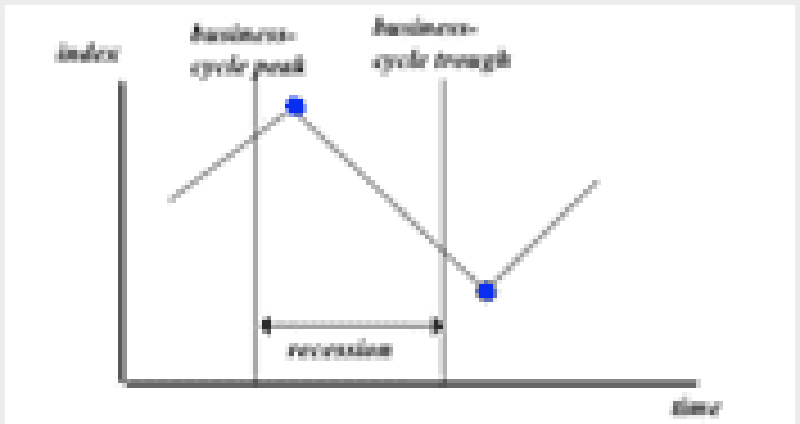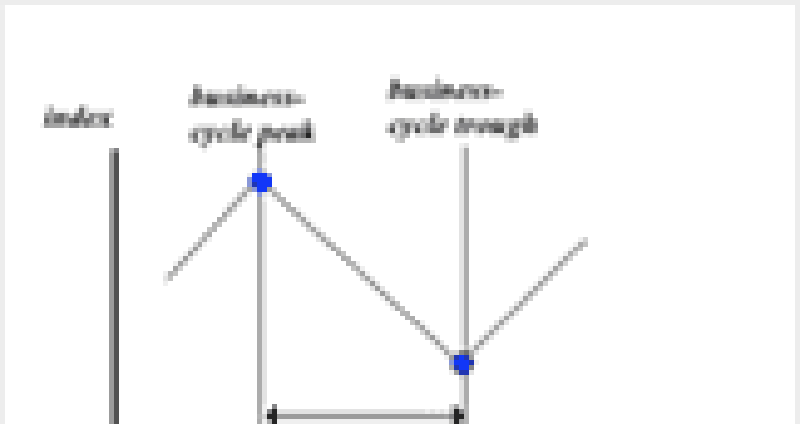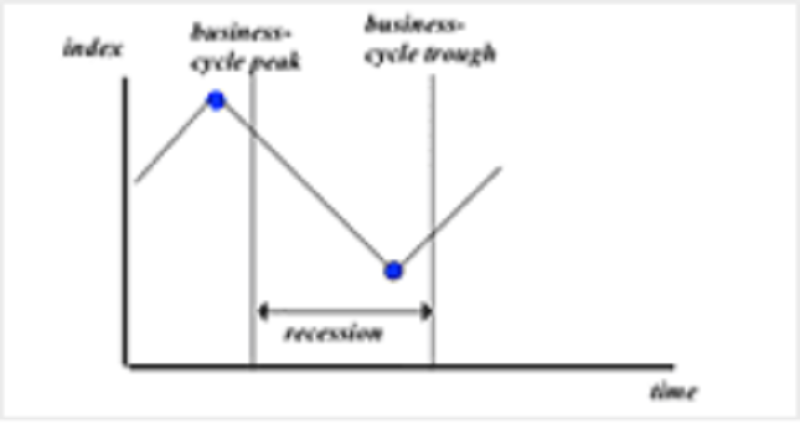Module 2
What component of GDP automatically corrects for the problem of “when value is produced?”
Change in business inventories
Net exports
Suppose that during January a diffusion index has a value of 80, but during February it has a value of 70, and during March it falls further to 55. What is the correct interpretation of these numbers?
The economy has clearly gotten worse from January to March.
The rate at which the economy has been improving is declining.
The economy did not start getting worse until March.
The economy is improving every month, but not as much as in February as March.
During lecture 7 we examined two diffusion indices-industrial production over a six-month span and employment over a six-month span-and looked at how they behaved during the 2001 and the 2007-2009 recessions. Which of the following statements is true?
Both diffusion indices fell below 25% during the 2007-2009 recession, but the lowest they got during the 2001 recession was about 30%.
Both diffusion indices fell below 25% during both recessions.
The industrial production diffusion index fell below 25% for both recessions, but not the employment diffusion index.
The employment diffusion index fell below 25% for both recessions, but not the industrial diffusion index.
The major market groups for the index of industrial production are:
Final products, non-industrial supplies, and materials
Final products, mining, and materials
Manufacturing of durable goods, manufacturing of non-durable goods, and utilities
Manufacturing, mining, and utilities

Consider the figure below. The figure illustrates:
A lagging economic indicator
A leading economic indicator
A coincident economic indicator
It is a stylized graph of the behavior of real GDP
In the rules of thumb for identifying a recession, the rule to determine if the amplitude and depth criteria are satisfied is
Real GDP declines for two consecutive quarters and the index of industrial production declines for six consecutive months.
The unemployment rate increases by 200 basis points and employment declines at least 1.5%.
An employment diffusion index based on a six month period falls below 25%.
None of the above.
In the lecture on employment and industrial production, we looked at four series of industrial production. Three of them were the overall index of industrial production, the index for manufacturing and the index for manufacturing of durable consumer goods. Which one of these most clearly tends to lead business cycle troughs?
None, all three clearly are coincident with business cycle troughs
The overall index of industrial production
The index for manufacturing
The index of durable consumer goods
Suppose that a group of manufacturing firms is asked whether orders for their product have increased, remained about the same, or decreased during the last month. Suppose also that 40% report that orders increased, 40% report that orders decreased, while the remainder reported no change. What would the value of the diffusion index be?
50
60
75
80
Which of the following is a problem with using real GDP as an economic indicator?
It is subject to substantial revisions that can in effect rewrite economic history.
It always either goes up or down.
It is the most comprehensive measure of output.
It has to be adjusted for changes in prices.
The highest unemployment rates usually occur
Several months after the end of a recession.
A month or two after the business cycle peak.
A month or two before the business cycle peak.
A month or two before the end of a recession.
In general, what does a diffusion index measure?
It is a measure of the share of a group of economic actors who report that a measure of economic activity is moving in a favorable direction.
It is a measure of how something is diffusing throughout the economy.
It measures the share of economic actors who think the economy is in good condition.
It is a measure of the share of a group of economic actors who report that a particular measure of economic activity is good.

Consider the figure below. The figure illustrates:
A coincident economic indicator
A leading economic indicator
A lagging economic indicator
A stylized graph of the behavior of the unemployment rate
How many business establishments are surveyed when data is being gathered to determine employment in the United States?
about 390,000
About 60,000
About 3 million
About 345,000
Which of the following statements is false?
The final estimate GDP is subject to revision every five years.
The advance estimate of GDP is released near the end of the last month of the quarter being measured.
The preliminary estimate of GDP is released near the end of the second month after the quarter being measured.
The final estimate of GDP is released near the end of the third month after the quarter being measured.

Consider the figure below. The figure illustrates:
A leading economic indicator
A coincident economic indicator
A lagging economic indicator
A stylized graph of the behavior of real GDP
One of the series discussed in the book A Guide to Everyday Economic Statistics is new jobs created. Which of the following statements about new jobs created is true?
New jobs created represents a change in an economic indicator, employment, so it is a leading economic indicator.
New jobs created is a lagging economic indicator.
New jobs created is a coincident economic indicator.
It is based on the household survey and this makes it a leading economic indicator.

The figure below could be a stylized graph for:
The index of industrial production (overall index)
Any leading economic indicator
The index for industrial production for durable consumer goods
The unemployment rate
The major industry groups for the index of industrial production are:
Final products, non-industrial supplies, and materials.
manufacturing, mining and utilities.
Final products, mining, and materials.
Manufacturing of durable goods, manufacturing of non-durable goods, utilities.
In the rules of thumb for identifying a recession, the rule to determine if the diffusion criterion is satisfied is
An employment diffusion index based on a six-month period falls below 25%.
Read GDP declines for two consecutive quarter and the index of industrial production declines for six consecutive months.
The unemployment rate increases by 200 basis points and employoment declines at least 1.5%.
None of the above.
Data for determining the level of employment
Is obtained from the current employment statistics survey.
Is gathered by the Bureau of Economic Analysis
Is obtained from state unemployment compensation offices
Is obtained from the current population survey
Suppose a recession is about to begin and you are thinking about refinancing your mortgage loan. Which of the following statements is true?
If you have a good credit rating, you should wait until the recession causes interest rates to fall before refinancing.
Regardless of your credit rating, you would be better off refinancing now before the recession causes interest rates to increase.
It does not make any difference when you refinance because recessions do not have any systematic affect on interest rates.
You should not pay any attention to interest rates because they don't help predict future economic conditions.
What share of GDP is accounted for by the goods in the index of industrial production?
30%
40%
20%
How did the levels of industrial production and employment during the late spring of 2012 compare with their peak values at the beginning of the 2007-2009 recession?
Both were still less than their 2007 peak values
Both were greater than their 2007 peak values.
The index of industrial production was greater than but the level of employment was less than its 2007 peak value.
The index of industrial production was less than but the level of employment was greater than its 2007 peak value.
Which of the following is not a common abuse of economic statistics?
The media sometimes treat a series as if it is a lagging economic indicator when it is not.
Applying them to situations for which they were never intended.
Focusing on or reporting nominal dollar values when the real or inflation adjusted figures give a better picture of how the economy is changing.
Reporting a new release of economic data without any accompanying information that will allow the reader or listener to evaluate the significance.
The lowest unemployment rates usually occur
A month or two before the business cycle peak.
A month or two after the business cycle peak.
Several months after the end of a recession.
A month or two before the end of a recession.
The unemployment rate is a more useful economic indicator than real GDP when looking for a business cycle peak because
it is a monthly series released in a more timely fashion than GDP figures
It is a quarterly series, where as GDP is monthly
The unemployment rate lags business cycle troughs
It tends to start going down before real GDP starts declining
Suppose that a group of manufacturing firms is asked whether orders for their product have increased, remained about the same, or decreased during the last month. Suppose also that 60% report that orders increased, 30% report that orders decreased, while the remainder reported no change. What would the value of the diffusion index be?
65
45
25
75
In the lecture on employment and industrial production, we looked at four series of industrial production. Three of them were the overall index of industrial production, the index for manufacturing and the index for manufacturing of durable consumer goods. Which one of these most clearly tends to lead business cycle peaks
The index of durable consumer goods
The overall index of industrial production
The index for manufacturing
All three clearly lead business cycle peaks
In the rules of thumb for identifying a recession, the rule to determine if the displacement criterion is satisfied is
The unemployment rate increases by 200 basis points and employment declines at least 1.5%
Real GDP declines for two consecutive quarters and the index of industrial production declines for six consecutive months..
An employment diffusion index based on a six month period falls below 25%.
None of the above.
{"name":"Module 2", "url":"https://www.quiz-maker.com/QPREVIEW","txt":"What component of GDP automatically corrects for the problem of “when value is produced?”, Suppose that during January a diffusion index has a value of 80, but during February it has a value of 70, and during March it falls further to 55. What is the correct interpretation of these numbers?, During lecture 7 we examined two diffusion indices-industrial production over a six-month span and employment over a six-month span-and looked at how they behaved during the 2001 and the 2007-2009 recessions. Which of the following statements is true?","img":"https://cdn.poll-maker.com/10-459804/mod2-1.png?sz=1200-000000100053"}
More Quizzes
الثروة اللغوية
20100
General knowledge 😂
520
Tell us which of these Disney Channel Original Movies you've seen and we’ll tell you which Disney villain you are!
100
FRIDAY OR SATURDAY, AMOUNT OF GIRLS (DAYTIME, UNTIL 7PM)
100
Disaster Nursing - Free Emergency NCLEX Practice
201024246
The Originals - Which Character Are You?
201020357
Big Picture vs Detail-Oriented - What's Your Focus?
201021681
Do I Have a Stutter - Free & Instant Results
201020931
Business Email Etiquette - Free Skills Check
201025350
Thunder Rolling in the Mountains Chapter Summary - Free
201019420
Cub Scout Trivia - Test Your Knowledge Free Online
201025350
Unit 1 Rhetorical Situation Practice - Free
201019420